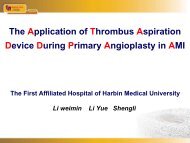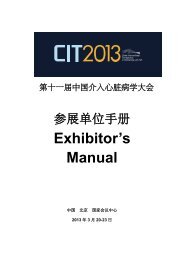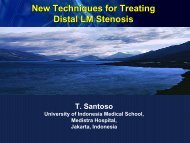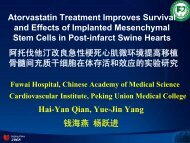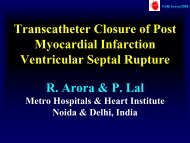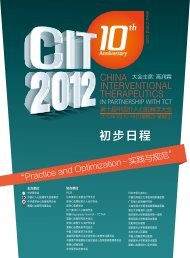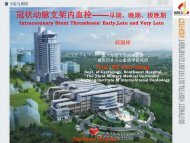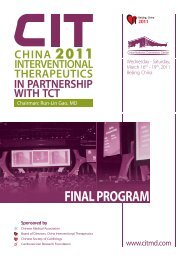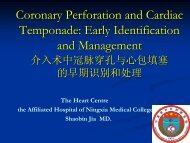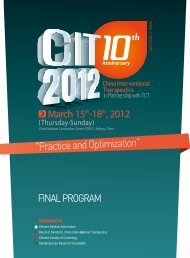Pandora's Box: The No-Reflow Phenomenon CIT-2008
Pandora's Box: The No-Reflow Phenomenon CIT-2008
Pandora's Box: The No-Reflow Phenomenon CIT-2008
Create successful ePaper yourself
Turn your PDF publications into a flip-book with our unique Google optimized e-Paper software.
Pandora’s s <strong>Box</strong>: <strong>The</strong> <strong>No</strong>-<strong>Reflow</strong> <strong>Phenomenon</strong><br />
<strong>CIT</strong>-<strong>2008</strong><br />
Jack P. Chen, MD, FACC, FSCAI, FCCP<br />
Chairman of Cardiology,<br />
<strong>No</strong>rthside Hospital<br />
&<br />
Director of Cardiac Studies,<br />
Saint Joseph’s s Translational Research Institute<br />
Atlanta, GA, U.S.A.<br />
Copyright © <strong>2008</strong> Saint Joseph's. All Rights Reserved.
Sister Olympic Cities<br />
WEST<br />
1996<br />
TO<br />
EAST<br />
<strong>2008</strong>
1996 Olympic Double-Gold Medalist:<br />
Women’s Table Tennis (China)<br />
Ms. Deng Yaping
“<strong>No</strong>-<strong>Reflow</strong>” or “Slow-<strong>Reflow</strong> ”:<br />
Definition<br />
• Angiographically: Contrast dye cannot reach<br />
(or reaches slowly) vessel terminus.<br />
• But no significant macroscopic coronary<br />
obstruction or dissection.<br />
• TIMI Frame Count (TFC): Increased<br />
(<strong>No</strong>rmal is 18-27).<br />
• TIMI Myocardial Blush Score (TBS): Decreased<br />
• CABG is of no benefit.
Macrovascular and Microvascular<br />
Obstruction Are Totally Different.
<strong>No</strong>-<strong>Reflow</strong>: Causes<br />
and Sequelae<br />
In-hospital MACE<br />
Microvascular<br />
Spasm<br />
Micro-emboli<br />
<strong>No</strong>-<strong>Reflow</strong><br />
Microvascular<br />
Compression by Edematous<br />
Myocyte<br />
Long-term MACE/Mortality<br />
Undetected<br />
Dissection<br />
Adenosine-<br />
(Deficient) Sensitive
We Call It:<br />
<strong>The</strong> “Cheese-grating” Effect
“<strong>No</strong>-<strong>Reflow</strong>” <strong>Phenomenon</strong><br />
How often does it occur<br />
Of reperfused patients: 29-44%<br />
Of reperfused LAD lesions: 50-80%<br />
Forman et al. Clin Cardiol 2007;30:583-5.
Commonly Occurring<br />
Scenarios<br />
• Acute Coronary Syndrome (ACS).<br />
• ST-Elevation Myocardial Infarction (STEMI).<br />
• Old, fragile, degenerated saphenous vein<br />
grafts (SVGs).<br />
• Rotational atherectomy, balloon angioplasty,<br />
stent-induced athero/thrombo-emboli.
<strong>No</strong>-<strong>Reflow</strong> Significantly Decreases Long-term<br />
Event-free Cardiac Survival<br />
• One report of 120 AMI<br />
patients undergoing primary<br />
PCI<br />
• <strong>No</strong>-reflow seen in 30 patients.<br />
• 5.8 + 1.2 years follow-up.<br />
• Significant mortality<br />
differences.<br />
Morishima et al. J Am Coll Cardiol<br />
2000;1202-9.
STEMI: Baseline Fibrinogen Levels<br />
May Be Important:<br />
• Study of 105 patients.<br />
• Fibrinogen levels not<br />
only predicted <strong>No</strong>-<br />
<strong>Reflow</strong>,<br />
• BUT (more importantly)<br />
predicted CK levels and<br />
anterior MI.<br />
Fibrinogen<br />
Level<br />
(mg/dl)<br />
(P=0.0004)<br />
<strong>No</strong>-<br />
<strong>Reflow</strong><br />
<strong>Reflow</strong><br />
523+198 395+145<br />
Wasilewski et al. Kardiologia Polska<br />
2006;64(9):967-72.
While previous trials reported<br />
that TIMI Flow Grade predicted<br />
STEMI/Primary PCI survival rate,<br />
recent data demonstrate that<br />
TIMI Myocardial Blush Grade<br />
may be more accurate.
TIMI Flow and<br />
Myocardial Blush Grade Differences:<br />
TIMI Flow Grade measures large epicardial coronary flow<br />
…but<br />
myocardial perfusion is dependent on microvascular flow.<br />
<strong>The</strong>refore, Myocardial blush likely more accurately measures<br />
microvascular as well as myocardial perfusion.
TIMI Myocardial Blush<br />
Grade<br />
Blush 0: Myocardium: no appearance of contrast blush or<br />
opacification<br />
Blush 1: Presence of contrast blush but no washout<br />
(clearance) of contrast (stain is present on the next<br />
injection)<br />
Blush 2: Blush clears slowly – clears minimally or not at<br />
all during three cardiac cycles<br />
Blush 3: <strong>No</strong>rmal myocardial contrast blush and washout<br />
(contrast is only minimally persistent after three cardiac<br />
cycles)
TIMI Flow Grade Cannot Predict<br />
Myocardial Blush Score<br />
Stone et al. reported: Acute MI/Primary PTCA Patients: although 94% had TIMI-3 3 Flow,<br />
only 28% demonstrated normal Myocardial Blush.<br />
Myocardial Blush Scores<br />
Following PTCA in AMI<br />
0/I<br />
30%<br />
II<br />
42%<br />
III<br />
28%<br />
Mortality<br />
.<br />
20.00%<br />
18.00%<br />
16.00%<br />
14.00%<br />
12.00%<br />
10.00%<br />
8.00%<br />
6.00%<br />
4.00%<br />
2.00%<br />
0.00%<br />
0/I II<br />
III<br />
Myocardial Blush Score<br />
• Stone et al. Abstract, AHA, <strong>No</strong>vember, 1999<br />
Thus, normal TIMI Flow<br />
cannot predict normal<br />
Myocardial Blush Score.<br />
But, more importantly:<br />
Low Myocardial Blush<br />
Score predicts mortality.<br />
Microvascular obstruction is likely<br />
due to microvascular spasm or<br />
embolism
To Reiterate:<br />
Myocardial Perfusion<br />
(Myocardial Blush Grade) and<br />
TIMI Flow are different<br />
Well-known CADILLAC Trial:<br />
Of all TIMI-3 Flow STEMI patients, only 17%<br />
demonstrated normal tissue perfusion (TIMI<br />
Blush Score).<br />
Forman et al. Cardiovasc Drug Rev 2006;24:116-47.
Gibson et al. reported:<br />
Post-PCI 30-Day to 1-Year MACE<br />
• Of all TIMI-3<br />
flow/PCI<br />
patients, 30-day<br />
to 1-year MACE<br />
is entirely<br />
dependent on<br />
Myocardial<br />
Perfusion<br />
Grade<br />
Gibson et al. Am Heart J 2002.<br />
0.12<br />
0.1<br />
0.08<br />
0.06<br />
0.04<br />
0.02<br />
0<br />
Cumulative 30 D-1 year<br />
MACE<br />
MPG = 3 MPG < 3
However, TIMI 10-B’s Data<br />
Are Discordant:<br />
• TIMI Grade 3 Flow (RR 0.61, p=0.047)<br />
AND<br />
• TIMI Myocardial Blush Grade (RR 0.50, p =<br />
0.038)<br />
BOTH Independently Predicted<br />
2-Year Mortality.<br />
Gibson et al. Circulation 2002.
Diagnosis<br />
• Angiography.<br />
• Magnetic Resonance Imaging (MRI).<br />
• Myocardial Contrast Echocardiography<br />
(MCE).
Angiographic Myocardial Perfusion Grade<br />
(MPG)
Magnetic Resonance Imaging (MRI):<br />
“Hyper-enhancement”<br />
• Before <strong>No</strong>-<br />
<strong>Reflow</strong>:<br />
<strong>No</strong> hyperenhancement.<br />
• After <strong>No</strong>-<br />
<strong>Reflow</strong>:<br />
Hyper-enhancement,<br />
which persists for 1<br />
year.<br />
Riccardi et al. Circulation<br />
2001;103:2780-3.
Myocardial Contrast Echocardiography
<strong>The</strong>rapy<br />
• Devices (Mechanical)<br />
– Aspiration<br />
– Distal Protection<br />
• Pharmacologic
Well-Known VeGAS-2 Trial<br />
(Angiojet, Possis)<br />
• 167 cases of SVG-PCI: Compared AngioJet thrombectomy<br />
(N=179) and Urokinase infusion.<br />
• AngioJet demonstrated:<br />
– Higher procedural success rate (86% vs. 73%).<br />
– Lower in-hospital MI rate (8% vs. 20%).<br />
– Lower 1-year MACE rate (20% vs. 40%).<br />
• BUT, Angiojet had NO 30-day mortality, Q-wave MI, TLR,<br />
stroke, stent thrombosis improvement/benefit.<br />
Cohen DJ, et al. Am Heart J 2001;142:648–56.
Recent NEJM:<br />
TAPAS Trial (Export, Medtronic)<br />
• Randomized Trial Reported 1,071 Cases<br />
of STEMI/Primary PCI.<br />
• Treatment Group: Used Export.<br />
Only 17.1%Demonstrated Final<br />
Myocardial Blush Grade-0/1.<br />
• Control Group: <strong>No</strong> Export.<br />
26.3% Demonstrated Final Myocardial<br />
Blush Grade-0/1.<br />
(P
SAFER Trial<br />
(SAphenous Vein Free of Emboli Randomized)<br />
(GuardWire, Medtronic)<br />
• SVG-PCI Report<br />
• 406 cases using GuardWire (Medtronic)<br />
distal protection plus stenting<br />
• 395 control cases of conventional (only<br />
stenting)<br />
• 30-day follow-up:<br />
– MACE decreased by 6.9% absolute<br />
reduction in (9.6% versus 16.5%, p=0.004).<br />
Baim et al. Circulation 2002; 105:1285-90.
Pharmacologic <strong>The</strong>rapy<br />
• Ideally, intracoronary (IC) administration<br />
medications should be made into vessel distal<br />
segment [via over-the-wire balloon central lumen or<br />
dual-lumen catheter (eg, Export*)].<br />
• Calcium blockers: diltiazem, verapamil, nicardipine,<br />
nicorandil.<br />
• Nitroprusside.<br />
• Adenosine.<br />
• Papaverine.<br />
• () Glycoprotein IIb/IIIa inhibitor.<br />
*Chen JP. J Invasive Cardiol 2006; 18(7): 346.
Prophylactic IIB/IIIA<br />
Inhibitor <strong>The</strong>rapy<br />
Reduces Short- and Long-term<br />
STEMI Mortality.<br />
Yip et al. Chest 2003;124:962-8.<br />
De Luca et al. JAMA 2005;293:1759-65.
HOWEVER, Regarding SVG-PCI,<br />
GP-IIB/IIIA Inhibitors Actually Have <strong>No</strong><br />
Survival Benefit<br />
• Large GP-IIB/IIIA Inhibitor<br />
and SVG-PCI randomized<br />
trials Meta-analysis<br />
included:<br />
EPIC, EPILOG, EPISTENT,<br />
IMPACT-2, PURSUIT all<br />
failed to demonstrate longterm<br />
MACE benefit.<br />
Roffi et al. Circulation 2002;106:3063-7.
Professor Gao Run-Lin<br />
and Fu-Wai Heart Hospital:<br />
Reported: (Mini-swine Model)<br />
• Fosinopril, Valsartan 1 , and Simvastatin 2 can<br />
open K ATP Channels and increase<br />
microvascular vasodilation,<br />
<strong>The</strong>se medications all reduced Myocardial<br />
Contrast Echocardiographic <strong>No</strong>-<strong>Reflow</strong>.<br />
1. Zhao et al. Coronary Art Dis 2006;17(5):463-9.<br />
2. Yang et al. Eur J Heart Failure<br />
2006;9:30-6.
Adenosine and Primary PCI:<br />
In AMISTAD-2 Trial post-hoc analysis Reported:<br />
• If Primary PCI was beyond 3 hours, adenosine<br />
conferred no survival benefit ;<br />
• However, if WITHIN 3 hours, earlier administration<br />
adenosine actually demonstrated significant<br />
6-month mortality/MACE benefits.<br />
• Adenosine (50-70 mcg/kg/min) IV vs. placebo during<br />
reperfusion therapy (within 3 hours of infarct)...<br />
Reductions in:<br />
6-month mortality: 7.3% vs. 11.2%, p=0.033.<br />
6-month cumulative MACE: 12.0% vs. 17.2%,<br />
p=0.022.<br />
Kloner et al. European Heart J 2006;27(20):2400-5.
Verapamil / Diltiazem /<br />
Nicardipine<br />
• Very effective in reversal of <strong>No</strong>-<strong>Reflow</strong>.<br />
• However, verapamil and diltiazem may<br />
lead to bradycardia, heart block.<br />
Werner et al. Cathet Cardiovasc Interv 2002;57:444-51.<br />
Wayrens et al. Am J Cardiol 1995;75:849-50.
Intracoronary Nitroprusside :<br />
Prof. Wang reported 11 Cases of AMI Slow-reflow<br />
or <strong>No</strong>-reflow<br />
• In 9 patients, TIMI<br />
Flow increased at<br />
least 1 Grade (82%,<br />
p=0.007).<br />
• In 8 cases had<br />
normal TIMI-3 flow<br />
(73%).<br />
Wang et al. Cathet Cardiovasc<br />
Interv 2004;63:171-6.
SCAI Recommendations<br />
Klein et al. Cathet Cardiovasc Interv 2003;60:194-201.<br />
PREVENTION:<br />
When treating diffuse disease or bulky, old friable SVG lesions,<br />
consider distal protection devices.<br />
For rotational atherectomy, consider use of nitroglycerin,<br />
verapamil, and heparin combination in the flush solution<br />
During acute coronary syndrome PCI, consider pretreatment with<br />
IIB/IIIA inhibitors.<br />
Minimize balloon inflations, consider direct stent deployment ,<br />
especially in SVGs.<br />
Pretreatment with verapamil or adenosine.
SCAI Recommendations<br />
TREATMENT<br />
Administer IC-nitroglycerine (100–200 μg up to 4 doses) to<br />
exclude epicardial spasm<br />
Consider administering a glycoprotein IIB/IIIA receptor<br />
inhibitor<br />
Administer pharmacologic agents through an infusion<br />
catheter or the balloon catheter central lumen to ensure drug<br />
delivery to the distal bed
SCAI Recommendations<br />
CLASS-I INDICATIONS: (Strong Clinical<br />
Evidence)<br />
•Adenosine (10–20 mcg bolus)<br />
•Verapamil (100–200 mcg boluses or 100 mcg/min<br />
up to 1,000 mcg total dose; with temporary<br />
pacemaker on standby)<br />
•Nitroprusside (50–200 mcg bolus, up to 1,000 mcg<br />
total dose)
SCAI Recommendations<br />
CLASS-II INDICATIONS: (Evidence Less<br />
Strong<br />
•Rapid, moderately forceful injection of saline or blood (to unplug<br />
microvasculature)<br />
•Diltiazem (0.5–2.5 mg over 1 min up to 5 mg)<br />
•Papavarine (10–20 mcg)<br />
•Nicardipine (200 mcg)<br />
•Nicorandil (2 mcg)<br />
•Epinephrine (50–200 mcg)
SCAI Recommendations<br />
CLASS-III: (Don’t Do It!)<br />
•Intracoronary nitroglycerin (for microvascular causes)<br />
•CABG (contraindicated)<br />
•Stent placement (if site of original stenosis is patent)<br />
•Thrombolytics (e.g., urokinase, t-PA)
Unusual Case<br />
Chen JP. J Invasive Cardiol 2007; 19: E89-92.<br />
• 19 year-old college student abusing massive quantities of<br />
Methamphetamine (stimulant similar to cocaine) sustained acute<br />
anterolateral STEMI/shock.<br />
• Cath: all coronary systems had “<strong>No</strong>-<strong>Reflow</strong>”, without visible epicardial<br />
stenoses.<br />
• EF=25%.<br />
• Thrombo-aspiration (Export Catheter) and IC-administration of<br />
adenosine/nitroprusside in all 3 coronary systems: <strong>No</strong> improvement.<br />
• Intra-aortic balloon pump placed.<br />
• Peak CK-MB: 6.8; Peak Troponin: 3.5.<br />
• Stabilized over next week.<br />
• Lost to follow-up post-discharge.<br />
• First reported case of methamphetamine-induced global “<strong>No</strong>-reflow” in the<br />
absence of visible coronary stenoses.<br />
• Mechanism unknown: Diffuse microvascular spasm vs. thrombi
“In Greek mythology, Pandora was the first woman on earth and had a<br />
jar which she was not to open under any circumstance. Impelled by her<br />
natural curiosity, Pandora opened the jar, and all evil contained escaped<br />
and spread over the earth, except for one thing, which lay at the bottom,<br />
and that was Hope.”<br />
-Encyclopedia Mythica
Similarly, when interventional cardiologists dare to open their Pandora’s<br />
NO-REFLOW <strong>Box</strong> and unleash all the associated Evils, we too, need Hope.<br />
(and some good drugs and devices)
Professor Andreas Gruentzig’s<br />
Original 1976 AHA Poster<br />
on First Angioplasty Experiment:<br />
On Display at<br />
Saint Joseph’s s Translational Research Institute
Thank you for your attention.




